Wild Wrasse harvesting - proposed mandatory fishing measures: consultation analysis
Analysis of responses and the outcome to the Wild Wrasse harvesting: consultation on proposed new mandatory fishing measures.
Analysis
Proposed Mandatory Wrasse Fishing Measures (Question 1)
Marine Scotland’s proposal makes the current voluntary measures obligatory and introduces new additional mandatory fisheries management measures.
Most respondents (56%) agreed all of the proposed measures without alteration and there was very strong support (ranging from 91 – 97%) for most of the measures individually.
Season Closure
The majority of respondents (71%) agreed with the proposal that the closed season should run from December 1st to 1st May but some proposed a range of alternative dates which they felt aligned better with the wrasse breeding season. There was a wide variety of dates suggested, including full closure, with many respondents commenting that research was needed to determine the spawning cycle of wrasse in Scottish waters for a more accurate and appropriate season closure.
“It is essential that there is a closed fishing season so that wrasse are given sufficient opportunity to breed before being subject to fishing pressure. The closed fishing season needs to allow sufficient time for fish to spawn and eggs to mature and hatch.”
Community of Arran Seabed Trust (COAST)
Respondents from the salmon farming industry agreed with the dates as proposed in the consultation paper and went on to state that extending the closed season into spring would have a detrimental effect on sea lice control. There were also feelings expressed by some respondents that as wrasse are largely inactive during the winter months, there would be no benefit from fishing them for aquaculture use in these conditions.
“Restrictions applied in other jurisdictions are not applicable in a Scottish context as environmental conditions differ significantly. Extending the close season further into spring would have significant, detrimental effects on lice control.”
Anonymous
Minimum and Maximum Landing Sizes
On minimum and maximum landing sizes 90% of respondents agreed to having landing sizes in place, with the majority (77%) supporting the sizes proposed, which are shown in Table 1.
| Species | Size Category |
|---|---|
| Goldsinny (Ctenolabrus rupestris) | Small (12cm – 17cm) |
| Rock Cook (Centrolabrus exoletus) | |
| Corkwing (Symphodus melops) | |
| Ballan (Labrus bergylta) | Large (12cm – 24cm) |
| Cuckoo (Labrus mixtus) |
Among respondents who did not support the proposed sizes, the main concern as shown in Figure 2, related to Ballan wrasse and specifically for the minimum size to increase by 3 cm to 15 cm. This was partly to bring Scotland more into line with English regulations but also because they believe the larger Ballan wrasse survive better in the salmon tanks. An opinion held by 17% of respondents who felt wrasse have a high mortality if caught below 15cm, indicating that some salmon farms (namely Loch Duart) do not accept individuals at the smaller end of the scale for these reasons. However there is disagreement among salmon farms around the minimum Ballan size and whether lower size affects survivability.
“I fish for Loch Duart who fish solely for ballan and take nothing under 15cm. I would like to see us have some leeway at the upper end.”
Dochas Marine Ltd.
“Landing Size: I agree that there should be a minimum landing size but that size should be increased to 15cm as salmon farmers report that Ballan Wrasse have high mortality under that size.”
Anonymous
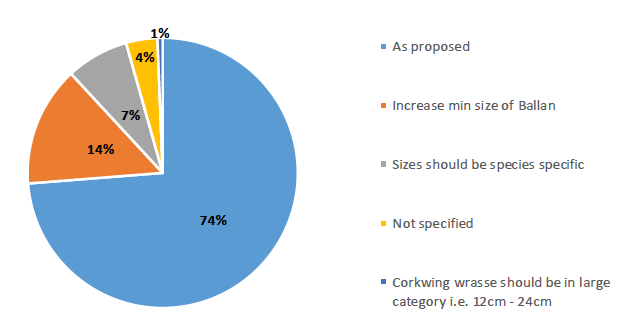
Specifically designed creels
Our proposal to permit only creels specifically designed to target and catch live wrasse and ensure their welfare received almost universal support, being approved by 97% of respondents. Those who disagreed didn’t see the need for specialised equipment or wanted the entire fishery closed.
Otter Exclusion devices
The same substantial majority (97%) supported otter exclusion devices, such as a fixed-eye aperture, being used at the entrance to the trap and creels having to feature escape hatches. Those who disagreed were evenly split between those who felt that “carapax” creels would be enough as the entrance is too small for otters and those who wanted the entire fishery stopped.
Maximum Lift rate of 6m/min
Our proposal that creels should be lifted at a maximum rate of six metres per minute was also strongly supported by respondents (94%). The main concern respondents had with this measure related to how this would be enforced.
Creels should not be deployed when water temperature is >17°C
There was similar (92%) support for the proposed measure that creels should not be deployed when the water temperature is >17°C. A few respondents expressed that the measure felt hypothetical as the water temperature in Scotland rarely reaches this range.
Maximum of 250 creels
Our proposal that vessels may deploy a maximum of 250 creels received substantial support (91% of respondents), as shown in Figure 3 below, of which 88% of respondents felt this proposed measure was set at the correct level. Those who are displayed as ‘other’ contributed to the general acceptance of a creel limit although there were mixed ideas as some felt tough restrictions would be better than none or for the entire fishery to be closed. Some in this group felt that the limits should be set by fishing area and were concerned that current demand was driven by poor management or care in salmon farms.
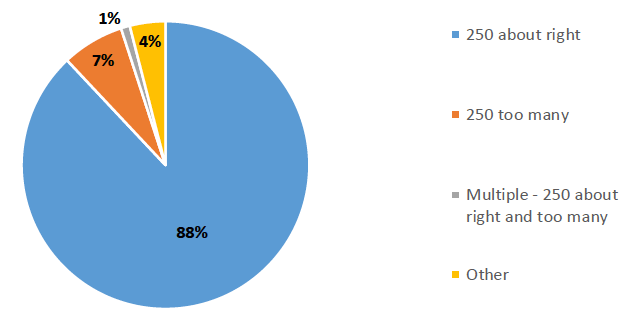
“I fished last year and have a contract in place. In my opinion 250 traps/creels is adequate per vessel to ensure that this fishery is not over fished.”
Anonymous Fisherman
A small minority (8%) of respondents said they were also concerned about the fishing effort connected with soak times with some leaving pots in the water too long while others were lifting pots too frequently.
Observer Requirement
A very strong majority (97%) supported the requirement to accept observers if requested and only a few objected to this measure. The main concern raised was related to the health and safety aspects of having extra people on board small vessels which already carry lots of equipment.
REM Requirement
There was also very strong support (95%) for our requirement that vessels will need to have REM or other appropriate inshore vessel monitoring if requested. Thoughts that emerged from the comments included a desire for more monitoring and that REM or similar should be made an industry standard.
A summary of the 154 responses is noted below in Figure 4. Over 90% of respondents supported all proposed measures. The exception was the closed season which was supported by 70% of respondents.
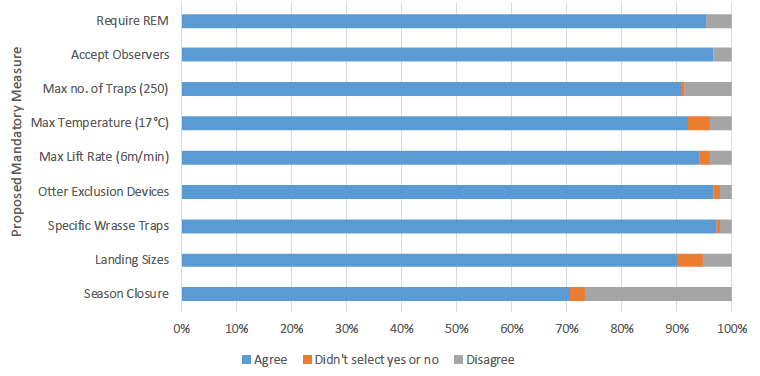
Marine Scotland Policy Response
The proposed measures included new mandatory controls covering the reporting of wild wrasse harvesting activity, seasonal closure of the fishery, minimum and maximum landing sizes, restrictions over the number of creels vessels may use, controls over the design and deployment of creels and specifications designed to protect fish welfare and improve mortality rates. Making these mandatory would give greater control over the fishery particularly with regards to enforcement in non-compliance cases.
A key aim is to ensure wrasse fishermen provide more comprehensive information about wrasse harvesting activity directly to Marine Scotland to help improve our knowledge base and science informed fisheries management and to simplify enforcement of the proposed management measures.
We will therefore require that fishermen submit additional and more comprehensive reports of catch, and, as set out below, will introduce appropriate electronic tracking and remote electronic monitoring (REM) of participating vessels and a requirement that they accept on-board observers if requested.
Marine Scotland will put in place the following measures.
Season Closure
The closed season will continue to run from 1st December – 1st May as proposed. Ballan wrasse, the predominant species used in salmon farming, attains peak spawning in May which indicates that spawning takes place earlier in the year. Based on the limited information available across all wrasse species and the relatively low level of wrasse landings (less than 5%) in May, the proposed closed season is appropriate for Scotland.
We recognise that there is a need for better data in this area and Marine Scotland will revisit this measure as appropriate as the science base improves.
Minimum and Maximum Landing Sizes
The minimum landing sizes were generally accepted to be reasonable although there was some support for changing individual values for some species, such as Ballan and Corkwing. We will therefore keep minimum and maximum sizes under review to aid in conservation and protect the reproductive populations of all the wrasse species. As the knowledge base improves Marine Scotland will reconsider the size restrictions as required.
Specifically designed creels
Marine Scotland will make this measure mandatory to protect wild caught wrasse during their capture, reducing stress or harm. Wrasse specific creels will also contribute to better quality of catch and should improve not only the welfare of caught wrasse but their ability to act as cleaner fish in the aquaculture pens.
Otter Exclusion devices
Marine Scotland will make otter exclusion devices mandatory to help ensure that otters will not become trapped within the creels. This will include devices such as fixed-eye apertures at the entrance to the creels, and escape hatches. We will seek advice from Naturescot on the specification of exclusion devices over the following weeks. The use of such devices is in line with current RSPCA Assured standards.
Maximum Lift rate of 6m/min
This important measure will be made mandatory as it has a direct beneficial impact on the welfare of the fish, reducing the risk of damage to the swim bladder. This measure is also in line with the RSPCA Assured standards.
Creels should not be deployed when water temperature is >17°C
Marine Scotland acknowledges this measure may be difficult to enforce however it helps reduce stress in the fish and is in line with RSPCA Assured measures and we will make it a mandatory control
Both the lift rate of 6 m/min and deploying creels when water temperature is >17°C are measures aimed at improving the health and welfare of the wrasse.
Maximum of 250 creels
Marine Scotland will make mandatory that fishers may deploy a maximum of 250 creels in harvesting wild wrasse. This creel limit is in line with existing voluntary measures to limit effort and it will be kept under review.
Observer Requirement
Vessels taking part in the fishery will be required to accept observers if requested and where operationally practicable. Primarily these will be scientific observers to obtain biological data about the fish caught and inform population management but we may also use other observers for enforcement purposes, if required. Marine Scotland acknowledges that this may require risk assessments and will liaise with each vessel to undertake this action as required.
REM Requirement
Marine Scotland will take forward the use of appropriate vessel tracking and monitoring (REM) on wrasse vessels as part of our wider proposals for inshore vessel modernisation under our Future Fisheries Management policy.
Proposed Criteria for the award of Wrasse permits (Question 2)
A key part of our new proposals for harvesting wild wrasse is that there will be mandatory controls brought into effect by a permit-style authorisation. To obtain such permission fishermen will need to be able to demonstrate their eligibility, i.e. a proven track record of wrasse harvesting and submitting returns over the last two years, and evidence of an appropriate contract with a salmon farm operator to supply wrasse. Those eligible will be able to apply for permission to harvest wild wrasse.
All fishermen currently supplying wrasse must be under contract with a farm and the contract binds them to the voluntary measures. This is to ensure that the wrasse caught are used appropriately and caught with the appropriate welfare practices to ensure they are in the highest condition possible to act as cleaner fish for aquaculture businesses.
There were mixed opinions for the proposed criteria with only 46% of respondents agreeing to all of the proposed eligibility criteria without alteration.
Permit Requirement
Taking each part individually showed that there is strong support for some form of permit scheme with 86% of respondents in agreement.
“There must be complete monitoring and tight controls on permits. … The demand from the industry will increase but this demand must not allow the precautionary principle to be ignored.”
Anonymous
Across respondents 12% noted that they wanted strict control by Marine Scotland in relation to the wild wrasse fishery, this included calls for those found not abiding by the rules to have their permit revoked. The strongest concern in this respect was in connection with other non-permitted vessels selling to permitted vessels in so called “wrasse deals” which would undermine the management measures.
In terms of limiting the number of vessels who would be allowed access into the fishery, respondents on average (68%) felt that the permit numbers were currently at the right level.
Salmon Contract Requirement
The requirement to have in place a contract with a salmon farm was agreed by 73% of respondents. Across all respondents 19% were concerned about the welfare of wrasse in general and 36% were concerned for the sustainability of wild wrasse fishing both in an ecosystem context and through levels/rate of harvesting. Both of these groups mainly consisted of environmental groups and members of the public although there was representation from every group. Currently each salmon contract has a requirement that fishers abide by the voluntary measures and other codes such as RSPCA Assured to ensure good husbandry and treatment of the live fish at all stages of the process. This requirement also provides an end destination for the wrasse caught.
“I feel that a contract to supply is the minimum entry for the wrasse fishery. Having a defined supply to a farm shows an end market for the product (wrasse)… and means that all fisherman will be mandatorily managed under a single system, which in the past has been voluntary and lacking robustness.”
Loch Duart Ltd.
A contract with an aquaculture company ties fishers into a price structure over which they have no control.”
Orkney Fisheries Association
Track Record
The requirement to have a two year track record, returned a fairly even split and respondents were marginally against this criterion with only 47% supporting it. Track record will be determined by those who fish using creels, have recorded wrasse in their landings over the last two years and are in possession of a valid UK fishing licence.
Responses reflected a range of concerns about track record. Fishermen not currently fishing for wrasse showed they were 55% against the criteria for the permits. Generally this was because they would be prevented from getting the required permission and thus diversifying into the fishery themselves, either through their concern about not having a salmon contract currently or a demonstrable two year track record. There was also some concern that the fishery would become a closed shop with only existing wrasse fishermen being able to participate.
“The stipulation of a 2 year track record means that those fishermen who are already in the fishery become part of a closed shop of wrasse fishermen. Those are fishermen who have been favoured already by companies and there is no provision for new entrants or others who may want to enter this fishery.”
Orkney Fisheries Association
Respondents who were identified as salmon farm operators also expressed concerns about the two year track record requirement as it might hinder efforts to recruit new suppliers, should they be needed. Specifically 78% of salmon farm operators thought that the length of two years for a track record was correct but that this should not be limited to wrasse as the fishery was originally set up as a diversification option, instead opting for two years in any fishery to allow access for new entrants. Respondents’ views on the length of the track record period regardless of their position on whether it should be part of the criteria for eligibility are displayed in Figure 5.
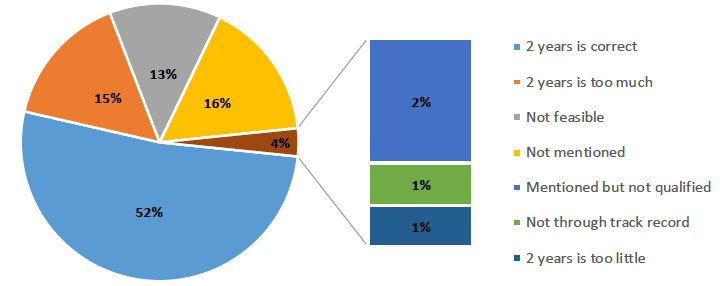
“I don't think it should be track record based. As we have seen the effects of track record based fisheries before. It should be based on the total area of available wrasse ground. This would be achieved using VMS and existing wrasse fleet, with additional vessels on trial areas. Not too many boats in one given area, (small areas within a fisheries area) A restricted total number of creels for a fisheries area, Shetland, Orkney, North coast, etc.”
Anonymous
New Entrants
The eligibility criteria with regards to new entrants was fairly split amongst respondents as seen in Figure 6. Those who wanted new entrants to be considered sought to stress the local benefit of the fishery and that this would in turn ease the pressure on other stocks such as crab and lobster. Those who did not want new entrants to be considered generally did so on the grounds that they didn’t want it to turn into a “free for all” and had concerns for the future of the fishery with some respondents requesting that the current level of those fishing wrasse should be kept as is or reduced until more research could be done to evaluate the stock(s) limit(s).
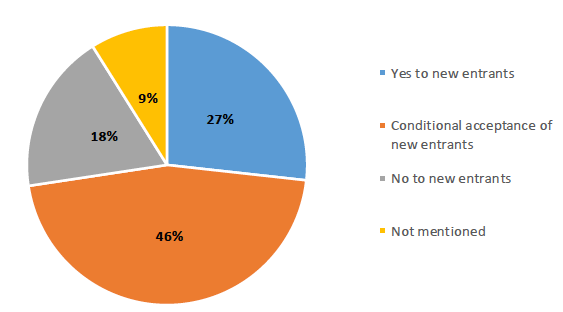
Many respondents included a range of conditions that they wished to be considered regardless of their stance on new entrants. These included: -
- change the number of permits depending on the stock health and through appropriate management to gauge how many permits should be distributed as flexible and employ proactive management;
- only allow new entrants when others leave the fishery, thus avoiding any sudden rise in fishing effort;
- for a specific area limit how many permits can be active in that area, judging on space available, the population dynamics and profitability;
- have a maximum number of permits per season and distribute these as required each year. This could also mean that if breaches occurred this could be taken into consideration when the next fishing season comes around. Thereby providing an extra incentive for those involved to follow the permit conditions carefully as loss of the permit would stop their ability to operate.
“I feel that new entrants to the fishery, particularly those who previously stated an interest to Marine Scotland, should be granted permits. Some fishermen have been unable to sell wrasse due to a constricted market, being controlled by a narrow range of buyers. One year’s figures should be sufficient in this new fishery, to prove intent.”
Anonymous
“Allowance must be made for new entrants into the fishery who have recently bought vessels and can demonstrate that they have discussed a supply contract with a salmon farming company, preferably at local level. No value should become attached to any permit and they should be non-transferable with the sale of a vessel.”
Western Isles Fishermen’s Association (WIFA)
“The Scottish Government should consider other factors, such as each prospective license-holder's history of compliance and if there are examples of non-compliance, licenses should not be awarded. The criteria should also seek to ensure that participants in the fishery operate in such a way as to protect the fishery's contribution to the local economy. … new licenses should only be issued within a framework that safeguards against overcapacity in the fishery.”
Anonymous
“The issuing of permits will have the effect of attaching price to wrasse permits and escalation in value of permits will be inevitable. The result will be permits becoming too expensive for new entrants and even moving out of the hands of active fishermen.”
Orkney Fisheries Association
Conversely, a number of comments from environmental groups advised strongly against opening up the fishery to everyone and this view was supported by existing wrasse fishers who felt this would lead to overfishing and competition for ground. It was further noted by these groups that instead of being an opportunity to take pressure off shellfish stocks such as crab and lobster, allowing too many new entrants would very quickly devastate the wrasse fishery as a whole and render it unstable in the medium to long term.
A summary of the 154 responses is noted in Figure 7 below.
Over 70% of respondents supported all proposed eligibility criteria. The exception was the track record requirement which was agreed by 47% of respondents. In Figure 7 it was noted that those who were in favour of new entrants under a condition were agreeing that new entrants should be considered.
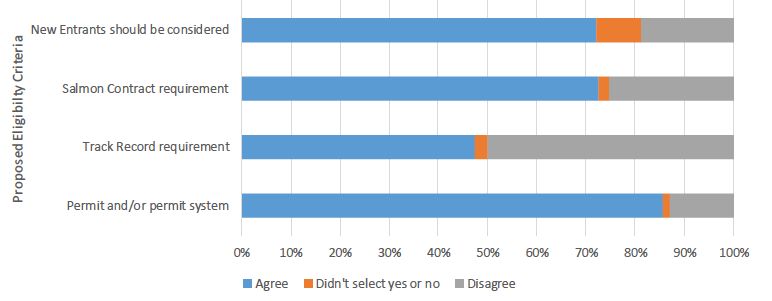
Marine Scotland Policy Response
Marine Scotland will put in place mandatory controls over the wrasse fishery. Under the new arrangements, we will introduce a licence variation closing the fishery to any fishermen that do not have permission from Marine Scotland to harvest wild wrasse. To obtain such permission, fishermen will need to demonstrate that they meet certain eligibility criteria.
The criteria will include a track record of fishing for wrasse by creel and submitting catch records in the 12 months prior to 10 March 2020. Fishers will also need to provide evidence of having an appropriate contract with a salmon farm operator to supply wrasse.
Those eligible will be able to obtain from Marine Scotland a letter of derogation permitting them to participate in the fishery. The letter will also set out the mandatory controls in place, conditions under which the derogation is granted and penalties that might apply if controls and conditions are not observed. For example, derogation to fish for wild wrasse might be suspended or withdrawn if offences merit that action.
Marine Scotland will ensure there is access for new entrants to the wrasse fishery and will work with the fishing sector and the Aquaculture Industry to develop a fair recruitment system that takes into account sustainability and the aspirations of fishermen who may wish to diversify. There will also be an appeals process for those who consider themselves eligible. These systems will be kept under review and we will look to refine them as more evidence, data and technology becomes available.
Each salmon contract currently has a requirement that fishers abide by codes such as RSPCA Assured to ensure good husbandry and treatment of the live fish at all stages of the process and it provides an end destination for the wrasse caught.
Marine Scotland letters of derogation will be issued at the beginning of each season and Marine Scotland will keep the overall numbers of derogations under review as more information on the health of wrasse stocks becomes available. These will be valid for one fishing season and will be reassigned each year.
Contact
Email: Inshore@gov.scot
There is a problem
Thanks for your feedback